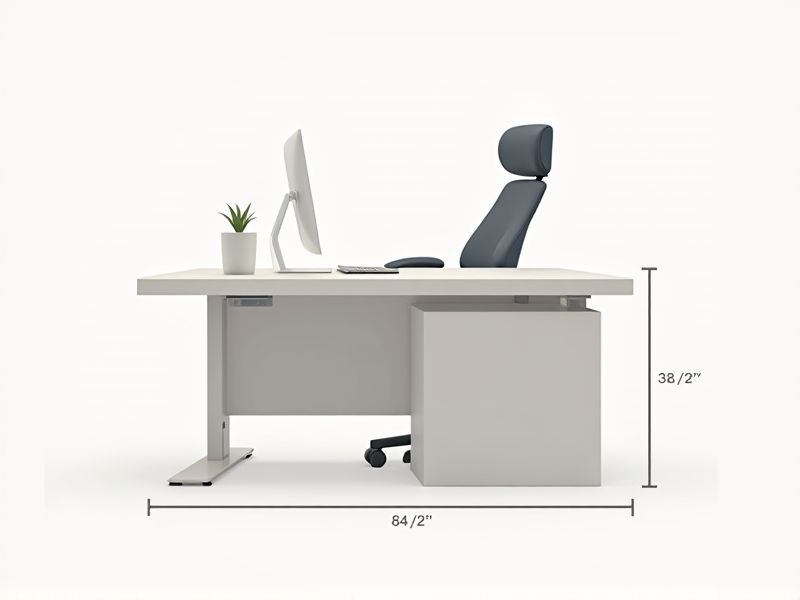
When choosing an office desk, it's helpful to know the standard dimensions to ensure comfort and productivity. Most office desks are typically 60 inches (152 cm) wide, 30 inches (76 cm) deep, and about 29-30 inches (74-76 cm) high. These measurements provide enough space for a computer, writing materials, and other work essentials, while also accommodating an average office chair. If you have limited space, smaller desks around 48 inches (122 cm) wide are also common and can fit more compact work areas effectively.
Ergonomic Design
An ergonomic office desk is designed to enhance comfort and productivity by promoting a natural posture, which is essential for health, especially during prolonged use. Studies show that an estimated 80% of office workers experience discomfort due to poor desk setups, making ergonomic solutions imperative. Height-adjustable desks allow users to alternate between sitting and standing, potentially reducing the risk of musculoskeletal disorders by up to 40%. Investing in an ergonomic office desk can significantly improve your work experience, leading to increased focus and efficiency throughout the day.
Height Adjustability
Height-adjustable office desks typically range from 24 to 50 inches in height, catering to a variety of user preferences and ergonomic needs. These desks promote better posture, reduce the risk of musculoskeletal disorders, and enhance productivity by allowing users to freely switch between sitting and standing positions. Many models feature electric or manual mechanisms, with electric options allowing for quick adjustments at the push of a button. Investing in a height-adjustable desk can lead to improved comfort and efficiency, potentially increasing your work performance by up to 15%.
Desktop Surface Area
The standard office desk typically offers a desktop surface area of at least 60 inches wide and 30 inches deep, providing ample space for essential equipment like computers, printers, and documents. A larger surface area can enhance productivity, allowing for better organization and easy access to materials. Ergonomic design is also a crucial factor, with a height range of 28 to 30 inches to accommodate different user preferences comfortably. A well-structured desk can significantly impact your work efficiency, promoting both comfort and productivity.
Legroom Clearance
An ideal office desk should provide at least 24 inches of legroom clearance to accommodate comfortable seating and movement. This measurement is crucial for promoting ergonomic posture, allowing you to maintain a natural position while working. The height of the desk should typically range from 28 to 30 inches, aligning with standard chair heights to enhance legroom. Ensuring that your workspace meets these standards can significantly improve your productivity and overall comfort throughout the day.
Material Durability
A high-quality office desk is typically constructed from durable materials such as solid wood, metal, or high-grade engineered wood. Solid wood desks, like oak or maple, possess a lifespan of over 20 years, while metal frames offer exceptional stability and longevity, often lasting a lifetime with proper care. Laminate surfaces, a popular choice, provide resistance to scratches and stains, making them ideal for heavy daily use, with some engineered wood options featuring a thickness of 25mm or more for added sturdiness. Investing in a desk made from these materials ensures not just aesthetic appeal but also a reliable workspace that can withstand the rigors of daily productivity.
Weight Capacity
The standard weight capacity for office desks typically ranges from 200 to 400 pounds, ensuring they can support various equipment and personal items. A heavier-duty desk designed for ergonomic use often accommodates loads of up to 500 pounds, ideal for multi-functional setups featuring monitors, printers, and other peripherals. When choosing your desk, consider the materials used, as steel frames generally provide superior weight support compared to wood. Make sure to verify the manufacturer's specifications to ensure the desk meets your needs for stability and functionality.
Cable Management Features
An office desk with efficient cable management features enhances your workspace by reducing clutter and increasing aesthetics. Look for desks that include built-in cable trays or grommets, enabling seamless organization of power cords and data cables. Desks with adjustable cable management options allow you to customize the layout according to your specific needs, accommodating multiple devices and their cables. Such features not only improve accessibility but also promote a safer and more productive working environment, helping you maintain focus and efficiency.
Storage Options
When selecting an office desk, prioritize storage options to enhance productivity and organization. Desks with built-in drawers and shelves can provide up to 50% more space for essential documents and office supplies, reducing clutter. Consider models with modular designs that allow for customization, enabling you to adjust the configuration as your needs change. Investing in a desk with multiple storage compartments can significantly streamline your workspace, ensuring that everything you need is easily accessible.
Standard Width
A standard office desk typically measures 60 to 72 inches in width, providing ample workspace for productivity. This width accommodates essential office equipment, including computers, printers, and stationery while allowing room for comfortable arm movement. Ergonomic considerations suggest that a desk should be at least 30 inches deep to support your workstation needs effectively. Ensuring your desk meets these width and depth standards can significantly enhance your work efficiency and comfort.
Standard Depth
A standard office desk typically boasts a depth of 24 to 30 inches, providing ample workspace for your daily tasks. This depth allows for comfortable placement of essential items like monitors, keyboards, and notepads, ensuring an organized work environment. In ergonomic terms, a depth of 28 inches is often recommended to maintain optimal posture and reduce physical strain during long work hours. Choosing the right desk depth not only enhances productivity but also contributes to overall workplace comfort and efficiency.
